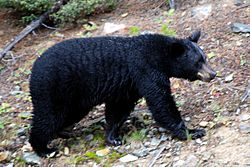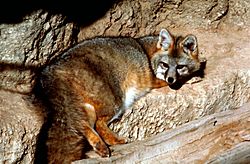Fauna of Louisiana facts for kids
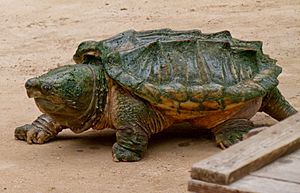
Louisiana is famous for its amazing wildlife! The state has many different natural areas, like low swampy lands, slow-moving rivers called bayous, creeks, thick woodlands, coastal marshes, beaches, and barrier islands. These habitats cover about 20,000 square miles (51,800 square kilometers), which is 40% of Louisiana's total land. Southern Louisiana alone has half of all the wetlands in the Continental United States, filled with countless bayous and creeks.
Louisiana has a warm, humid climate, much like other Southern states. Summers are long, hot, and humid, while winters are short and mild. This is largely because of the Gulf of Mexico, which is never more than 200 miles (320 km) away. Louisiana's varied natural areas, including tidal marshes, swamps, forests, and prairies, are home to many different kinds of animals.
Some of the most common animals you can find across Louisiana include otters, deer, minks, muskrats, raccoons, opossums, rabbits, squirrels, nutria, turtles, alligators, woodcocks, skunks, foxes, beavers, ringtails, armadillos, coyotes, and bobcats. Many of these animals, like deer and rabbits, are hunted for sport. Others, like muskrats and minks, are important for their fur. Louisiana also has unique plants and animals found nowhere else, such as the white leucistic alligator. The Pearl River map turtle and the ringed map turtle live only in Louisiana and nearby State of Mississippi.
Louisiana protects many of its natural areas. These include National Park Service sites, the Kisatchie National Forest, state parks, and many Wildlife Management Areas. The Nature Conservancy also helps manage natural spaces.
Contents
Louisiana's Amazing Habitats
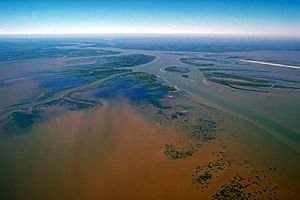
Much of Louisiana's land was formed by mud and sand carried down the Mississippi River. This created huge deltas and vast areas of coastal marsh and swamp. The northern parts of Louisiana are mostly woodlands. These forests are home to deer, squirrels, rabbits, bears, muskrats, minks, opossums, bobcats, and skunks. Louisiana's forests have many types of trees, like oak, pine, beech, black walnut, and cypress. In the Piney Woods area, you might find mammals like the North American cougar, gray fox, and feral hogs (also called razorbacks). Snakes like the western cottonmouth and Louisiana pine snake are also common here.
Kisatchie National Forest, Louisiana's largest forest, is in the central part of the state. It covers about 600,000 acres (2,400 square kilometers). This forest is home to 155 types of birds, 48 mammal species, 56 reptile species, and 30 amphibian species. It has important flatwood areas that support many rare plants and animals. These include the Louisiana pine snake, the red-cockaded woodpecker, the Louisiana black bear, and the Louisiana pearlshell.
Alligators are very common in Louisiana's swamps, bogs, creeks, lakes, rivers, and bayous. Other water-loving reptiles, like the alligator snapping turtle, also live in the Louisiana swamps. This turtle has a very large head and three rows of spiky scales. Louisiana's wetlands are perfect homes for many types of turtles, crawfish, and catfish. These are all popular foods in the Acadian culture.
One animal that has caused problems in Louisiana's wetlands is the nutria. This rodent from South America was brought here for fur farms and later escaped.
Mammals of Louisiana
Louisiana is home to 40 different types of mammals, not including marine mammals like dolphins. If you count those in nearby waters, the number goes up to 70! For example, Louisiana has two kinds of squirrels: eastern gray squirrels and fox squirrels.
The state also has two types of rabbits: eastern cottontails and swamp rabbits. Cottontails usually live in higher, drier areas, while swamp rabbits prefer wetlands. However, you can find both types throughout Louisiana. Rabbits can have many babies when their habitat and weather are good.
Louisiana Black Bear
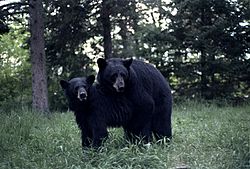
The Louisiana black bear used to live all over Louisiana and in parts of nearby Mississippi, Arkansas, and Texas. These bears were common when the first European settlers arrived. Native Americans had hunted them for food for many generations.
By the late 1950s, most black bears were found in the northeast part of Louisiana and in the lower areas of the Atchafalaya Basin. Today, black bears can be seen in all parts of Louisiana. However, most are found in specific parishes in the northeast and central parts of the state.
People used to hunt black bears in Louisiana until the late 1980s. The hunting season was closed in 1988 and has stayed closed since then. Between 1964 and 1967, 161 black bears were brought from Minnesota and released into Louisiana's river bottoms. This was an effort to help the bear population grow again. By 1968, these bears were having babies. However, many of the relocated bears were killed by cars or as nuisance animals.
Good news! As of 2016, the Louisiana black bear is no longer considered an endangered species.
Reptiles of Louisiana
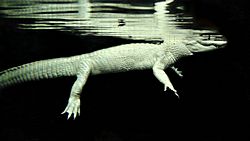
The American alligator is Louisiana's official state reptile. This iconic animal of Louisiana's wetlands has made a great comeback from being almost extinct. Now, they are quite common. Louisiana is also home to many snake species. These include the eastern diamondback rattlesnake, Texas coral snake, eastern yellowbelly racer, and the cottonmouth.
America's largest freshwater turtle, the alligator snapping turtle, lives in the same habitats as its relative, the common snapping turtle. The green American chameleon also lives in the wetlands. Other reptiles in Louisiana include the gopher tortoise and the slender glass lizard.
In 2014, there were over one million alligators in Louisiana, and their numbers continue to grow. Alligators love swamps, rivers, lakes, or any place with a good habitat. Louisiana also has several types of venomous snakes. These include the eastern coral snake, eastern copperhead, cottonmouth, and various rattlesnakes.
The biggest American alligator ever reported was a male killed in 1890 on Marsh Island in Louisiana. It was said to be 19 feet (5.8 meters) long!
Birds of Louisiana
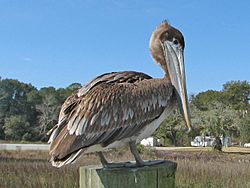
About 160 bird species live in Louisiana all year or breed there. Another 244 species regularly migrate through or spend winter in the state. Many of these are shorebirds and songbirds. In 1902, the eastern brown pelican became part of the Seal of Louisiana. Ten years later, in 1912, the pelican and its young were added to the flag of Louisiana. Louisiana's official nickname is the Pelican State.
In 1958, the pelican was made the official state bird of Louisiana. This was changed in 1966 to specifically name the brown pelican. The National Basketball Association team, the New Orleans Pelicans, is named after Louisiana's state bird. The eastern brown pelican is also the national bird of Barbados and the Turks and Caicos Islands. It is a mascot for Tulane University and appears on the seals of Tulane University, Louisiana State University, and the University of Louisiana at Lafayette.
Shore birds are very common in Louisiana. The most common is the great white egret. This large, all-white heron has impressive wings and stands tall. The egret is often seen in Louisiana's wetlands and coastal areas, where it finds plenty of fish, amphibians, and small mammals to eat. This bird is also the official symbol of the National Audubon Society.
The American bald eagle nests in southeastern coastal parishes and sometimes on large lakes in northern and central parishes. Some of America's tallest birds, like the great blue heron and great egret, love the fishing opportunities in Louisiana's swamps. Birds of prey, such as the osprey, American black vulture, and barred owl, live in the marshes of southern Louisiana. Many migratory waterfowl and songbirds stop over or spend the winter in these wetlands.
Amphibians of Louisiana
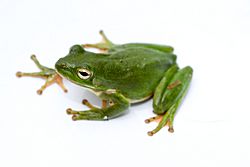
The American green tree frog was named Louisiana's official state amphibian in 1993. Other amphibians in Louisiana include salamanders like the eastern tiger salamander and three-toed amphiuma. There are also toads, such as Hurter's spadefoot toad and southern toad, and frogs like the pig frog and bronze frog. American bullfrogs are the largest frogs found in Louisiana.
Fish of Louisiana
The white perch, also called sac au lait in Cajun French, became Louisiana's official state fish in 1993. Sea turtles live on coastal beaches. Freshwater fish include bass, crappie, and bream. Red and white crawfish are very important for commercial fishing.
Many sharks have been seen in Louisiana waters, including lemon sharks, tiger sharks, bull sharks, and blacktip sharks. Bull sharks have even been seen far up the Mississippi River and in inland bayous. The alligator gar and the frecklebelly madtom are two other fish species found in Louisiana.
The bowfin, known by many names like mudfish or choupique (pronounced shoe-pick), is found in many areas of Louisiana.
Endangered Species in Louisiana
Some animal species in Louisiana are threatened or endangered. These include five types of sea turtles: green, hawksbill, Kemp's ridley, leatherback, and loggerhead. In 2003, 23 Louisiana animal species were on the U.S. Fish and Wildlife Service's threatened and endangered list. This list included the Louisiana black bear, American bald eagle, and red-cockaded woodpecker.
The mountain lion population in Louisiana is small but has been growing recently. The Florida panther used to live from Florida to Louisiana, but today, wild Florida panthers are only found in southwestern Florida. The Louisiana black bear has been taken off the endangered species list, which is great news! The Mississippi diamondback terrapin is considered a "species of concern" in Louisiana, especially near the Mississippi border.
Invasive Species
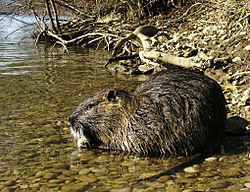
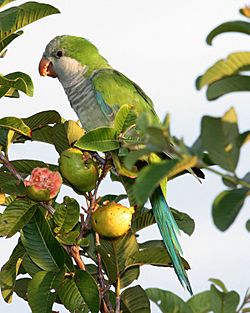
Nutria
In the 1930s, a man named Edward McIlhenny brought 13 adult nutria from Argentina to his home in New Iberia. He wanted to start a fur farm. Two years later, 150 nutria escaped, possibly during a storm. The nutria had babies very quickly, and their numbers grew by thousands each year. By the 1960s, there were as many as 20 million nutria! By the time the government started a program to control them, the nutria were destroying Louisiana's marshes and wetlands, causing a lot of erosion. Today, the nutria is one of the most common and disliked pests in Louisiana.
The story of the nutria is not unique. Many species of birds, mammals, fish, and plants have been brought into Louisiana from other places over the past two centuries. These "exotic species" or "invasive species" can cause big problems for the local ecosystems. Some invaders, like the vine kudzu, destroy the homes of native wildlife. Other species compete fiercely with native plants and animals for food and resources.
Some experts believe that invasive species are the second biggest threat to endangered species, after losing their habitats. Nutria were brought to coastal marshes in the mid-1900s, and their population has exploded into the millions. They cause serious damage to coastal marshes and can dig holes in levees (protective walls). Because of this, Louisiana has offered a bounty (money for each one caught) to try to reduce nutria numbers.
Large alligators eat a lot of nutria. So, alligators might help control nutria populations in Louisiana. They might even stop them from spreading east into Florida and the Everglades.
Monk Parakeet
The monk parakeet is a farm pest in its home country of South America. It was first brought to the U.S. as a pet bird. They were so popular that over 60,000 were imported between 1969 and 1972. By the 1980s, they had been released in many parts of the country and started small breeding groups. Twenty years later, monk parakeet numbers have grown a lot, but they are still found in scattered areas.
Monk parakeets usually stay in cities. They feed and nest in palm trees, using a space that no native bird uses. So far, in Louisiana, they have mostly stayed in the City of New Orleans. They have not caused problems for local wildlife there. However, if their numbers grow, monk parakeets could become a serious threat to farms, just like they are in their native South America.
Red Fire Ant
The red fire ant came from South America and has spread widely in many southern U.S. states since the 1930s. These ants look like most other ants, but they are fierce predators. They attack birds, rodents, and even larger mammals in swarms.
One study on white-tailed deer found that twice as many young deer died in areas with fire ants compared to areas without them. In Louisiana, the spread of fire ants has been linked to fewer loggerhead shrikes and some types of warblers. The red fire ant has replaced almost half of the native insect species in some areas it has taken over.


